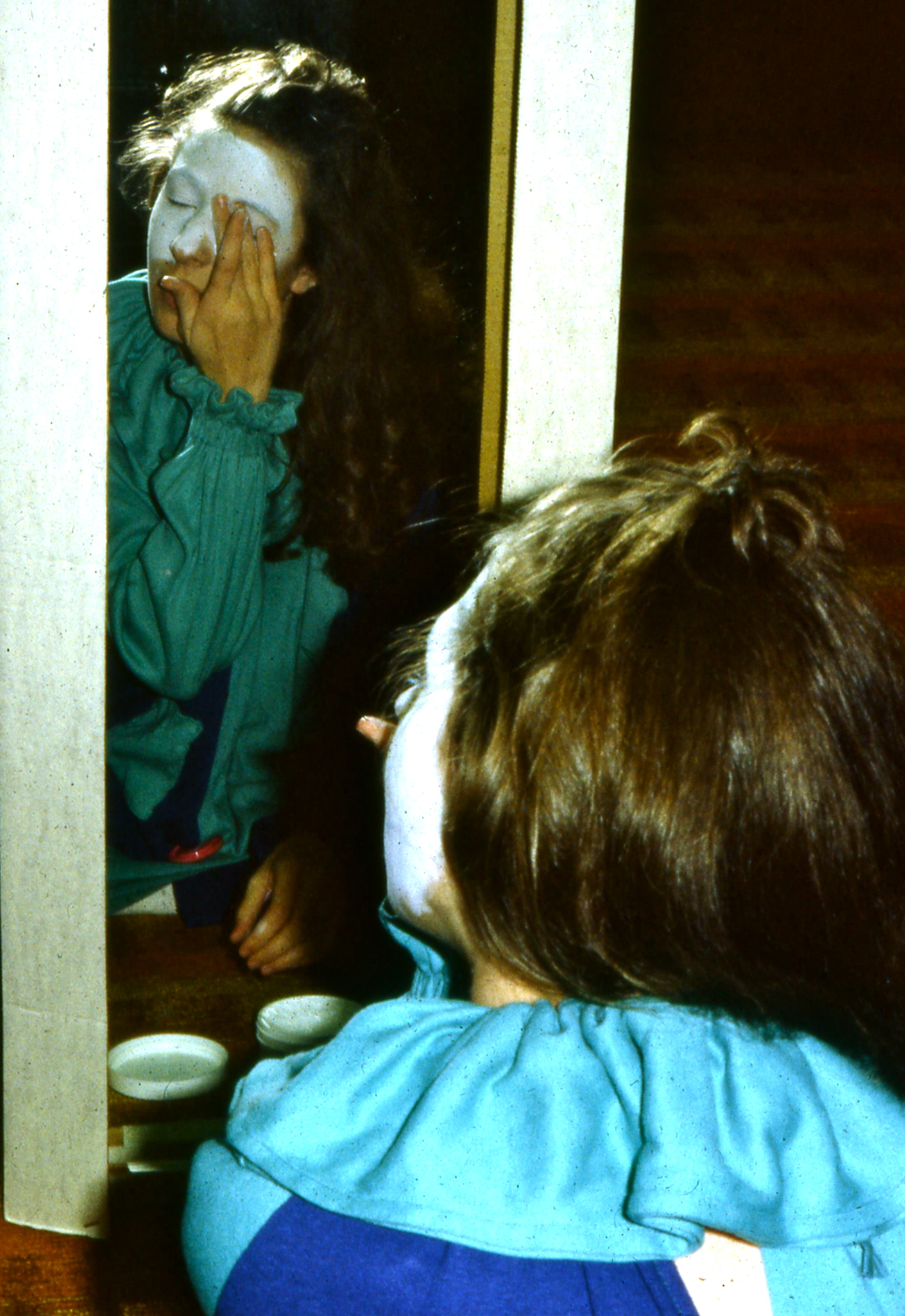“When you’re different, sometimes you don’t see the millions of people who accept you for what you are. All you notice is the person who doesn’t.” ~ Jodi Picoult, Change of Heart
Tag Archives: relationship
Leaning in…
I was listening to a Hazelden webinar on adolescent suicide. The presenter talked about the importance of engaging the suicidal teen, encouraging them to talk. She identified the three most important words to say when you’re the one being told, “Sometimes I feel like killing myself.” What were the words she thought had such power to connect? “Tell me more.” Three small words with the potential to change the course of a person’s life.
“Tell me more.” Three words that invite someone to share their pain and confusion. Why are those words so often left unspoken? Perhaps because encouraging someone to hand us their pain may be the right thing to do, but it is rarely the easy thing to do. In fact the willingness to stand and hold another’s pain often leaves us facing our own discomfort.
“Tell me more.” I replayed those three words as I went about my day. I thought about how they fit other situations. How powerful those words could be with those who grieve. How in the midst of grief we long for someone to ask us to tell them more about who and what we have lost. How holding the pain of someone else’s loss feels uncertain and uncomfortable, and so we hold back.
I was still chewing on the benefit and difficulty of “Tell me more”, when my weekly dose of Modern Family came on. It is Phil Dunphy’s favorite day, leap day. He has big plans to do something out of the ordinary to celebrate. But as the day continues, things begin to fall apart. Phil pulls the two boys, Luke and Manny aside in an attempt to salvage their celebration. He leans toward them and says in a low, somber voice, “I have a plan.” The boys just stand there. Phil adds, “It’s kind of traditional to lean in when someone says they have a plan.” Both boys immediately lean into the circle. No hesitation. Focused.
That’s when it came to me. What Phil Dunphy had to say was important. And when someone has something important to say, we need to lean in. To lean in and embrace what is being said, giving the words, the feelings, and the person our presence. Perhaps no territory feels more uncertain and overwhelming than the landscape of grief and loss. When we find ourselves in the presence of wounded travelers and their story, needing to lean in, our first impulse may be to just stand there. Sometimes we even step away.
Forty five years ago, John Drakeford wrote a book titled, The Awesome Power of the Listening Ear. It was a book about the “power of simply listening to others”. I think Drakeford’s intent was to help us push past discomfort to a place of leaning in. A place of inviting others to tell us their stories. What if in the presence of grief and loss, we begin to lean in, and quietly say “Tell me more.”
“Oh, the comfort, the inexpressible comfort of feeling safe with a person, having neither to weigh thoughts nor measure words, but pouring them all out, just as they are, chaff and grain together, certain that a faithful hand will take and sift them, keep what is worth keeping, and with a breath of kindness blow the rest away.” ~ George Eliot
I went to their resting place,…
Carol at Carol Wiebe Wonders Out Loud, asked me not long ago if I ever wrote poetry. I told her I did occasionally. So Carol, here is one from a long time back. I chose to post it now to add to the ongoing conversation about loss and grief. Thanks for asking, Carol. I look forward to seeing where your thoughts on shared mourning “artfully” take you.
Shared Mourning
Not planning to go, but
Drawn there just the same
I went to their
Resting place, and
You stayed by me.
I walked among grey stones
Under grey skies leaving my
Burden in shallow graves of
Sunken footsteps in the
Rain soaked ground, and
You walked with me.
Their stories came not in the
Rushing torrent of new grief but
Slowly, gently, quietly as a
Stream, small but sure, flows
Always toward its rest; I
Spoke with quiet grief, and
You heard me.
Silence settled softly on me,
Around me, with gentle tears
Raining down from grieving sky.
My sorrow cradled in your eyes, I
Remembered those who sleep.
You held my silence.
Shoulders touching, we sat each
Alone, yet bound by strong,
Unspoken words of grief and
Joy for those we love.
Comfort came in our shared mourning.
The Lazy A
Oh! dear old barn, where my childish days
Were passed full oft, how I long to be
Only a child again, to play
Beneath thy roof with the old-time glee!From The Old Barn, by Mary Dow Brine (1816-1913)
The inconvenience of truth…
I do most of my radio story listening in the car. I hear bite size sound spurts while going to and from work, running errands, or some other quick trip reason. Sound bite stories can be frustrating if you want the whole story. Sound bites stories can be great, if what you love is the seed they plant that sends your mind chasing after ideas. One of my sound bite seeds came several months ago while listening to “The Takeaway” interview with Ted Danson.
The part I heard introduced me to Oceana: Our Endangered Oceans and What We Can Do To Save Them, a book co-authored by Danson. I was listening,…sort of, knowing the story would be interrupted by me getting out of the car. As I pulled into a parking place, I heard the host refer to Al Gore’s An Inconvenient Truth. I was out of the car, but the seed of “an inconvenient truth” had been planted. An inconvenient truth. I began to think about the dilemma of what to do with truth that is inconvenient. We’re used to hearing about the inconvenient truth of climate change and environmental concerns. Are there other inconvenient truths? What makes a truth inconvenient anyway? That it’s difficult, or unpleasant?
That’s when it dawned on me that the main thing that makes a truth inconvenient, is that it is true. That in fact, much of the truth that matters in this world is terribly inconvenient, and that it usually involves change. A changing world. Changes we need to make. Accepting change in someone or something else. Truth often asks us to take a stand, in spite of great cost. It doesn’t get much more inconvenient than that. The possibilities are ever “changing”. When I think about it,…
- It’s inconvenient to discover the truth that being a parent means setting limits.
- It’s inconvenient to balance the hard and soft jobs of parenting, when our kids think we’re great, and when they don’t like us.
- It’s inconvenient that relationships stretch us, scrutinize us, call us to grow.
- It’s inconvenient to do what we said we would do, to be who we said we would be.
- It’s inconvenient to be criticized, sometimes for doing the right thing.
- It’s inconvenient to look at the impact our choices have on other people, places, and things,… and perhaps redecide.
We can focus on avoiding and escaping these small and large inconveniences…but we can’t escape the fact that inconvenience doesn’t make truth any less true. Anyway you spin it, truth can be real inconvenient. What is the most inconvenient truth in your lesson plan today?
“Men stumble over the truth from time to time, but most pick themselves up and hurry off as if nothing happened.” — Winston Churchill
Valentine’s Day and the other 364…
I don’t know how true it is in other countries, but in the United States we are big on Valentine’s Day. You only have to walk in any store by the first of February to witness our commitment to this heart felt day of expressing our love for the important people in our lives. Aisles and displays of stuffed animals, boxes of candy, flowers, in a million shades of red and pink. Valentine’s Day is all about love and loving.
So why would anyone want to cast a shadow on this day of love by bringing up domestic violence? Maybe because no matter how much we love this one day, I want to know about the other 364 days of the year. We have a problem 364 days of the year. Actually it is such a big problem that it happens on this special day of love too. We have a serious problem with domestic violence. We are violent toward those we say we love. We hurt each other in private, in public, and in front of our children. We see cuts and bruises and we keep our silence.
The Makers of Memories Foundation have identified:
Top 10 Alarming Facts About How Domestic Violence Impacts Kids
1. 63% of all boys, age 11-20, who commit murder kill the man who was abusing their mother
2. 75% of boys who are present when their mothers are beaten were later identified as having demonstrable behavior problems
3. Children from homes characterized by domestic violence are five to seven times more likely to experience significant psychological problems relative to children in the general population.
4. Domestic violence exposed children are four times more likely to visit the school nurse.
5. More than half of school age children in domestic violence shelters show clinical levels of anxiety or post-traumatic stress disorder.
6. Researchers have linked exposure to chronic abuse and violence with lower IQ scores, poorer language skills, decrements in visual-motor integration skills and problems with attention and memory.
7. Cognitive problems associated with exposure to violence and abuse comprises one of the most direct threats to the developmental task of school adaptation and academic achievement. Read the complete article…
Make this the most loving and significant
Valentine’s Day ever.
Love responsibly.
Find your voice.
Speak out
Against domestic violence.
Singing my ABCs…
I want to say big thank you to Debbie at Two Minutes of Grace, for sharing the ABC award with me. The time it has taken me to respond is no indication of how much I appreciate being thought of by Debbie.
The ABC instructions are:
Add the logo to your site.
Pass the ABC award on to other bloggers.
Use the alphabet to make a list of words describing you so readers will learn more about you.
I am pleased to pass the ABC award along to these wonderful bloggers:
“No book is really worth reading at the age of ten which is not equally, and often far more, worth reading at the age of fifty and beyond.” ~ C.S. Lewis
Debbie, I borrowed your C.S. Lewis quote to introduce my ABC list, not of words, but of children’s books I love. Some are from my own childhood, some from my daughters, and some I have enjoyed reading to my grandchildren. I have used many of them in my therapy practice with people of all ages.
An Alphabet of Children’s Books
Alexander and the Terrible, Horrible, No Good, Very Bad Day – Judith Viorst
Angelina Ballerina – Katharine Holabird
Are You My Mother? – Phillip D. Eastman
Best Friends for Frances – Russell Hoban
Corduroy – Don Freeman, Calamity – Camilla Ashworth
Dinosaur’s Divorce – Marc Brown
Ella the Elegant Elephant – Carmela & Steven D’Amico
Franklin in the Dark – Paulette Bourgeois
Giving Tree, The – Shel Silverstein
Guess How Much I Love You – Sam McBratney
Horatio’s Bed – Camilla Ashforth
I Promise I’ll Find You – Heather Patricia Ward
I Was So Mad – Mercer Mayer
Just Like You – Jean Fearnley
Just Go to Bed – Mercer Mayer
Kissing Hand, The – Aubrey Penn
Llama, llama, Red Pajama – Anna Dewdney
Miraculous Journey of Edward Tulane – Kate DiCamillo
Midnight Farm, The – Reeve Lindbergh
Not A Box – Laura Vacaro Seeger
Oh The Places You’ll Go – Dr. Seuss
On The Night You Were Born – Nancy Tillan
Polar Express, The – Chris Van Allsburg
Quiet Book, The – Deborah Underwood
Ride a Purple Pelican – Jack Prelutsky
Stellaluna – Janell Cannon
Snowy Day, The – Ezra Jack Keats
Talking Like the Rain – X.J. & Dorothy M. Kennedy
Up and Down – Oliver Jeffers
Velveteen Rabbit, The – Margery Williams
Whale’s Song, The – Dyan Sheldon
Pooh’s Xylophone Book, closest I could come to get an “X”.
You and Me, Little Bear – Martin Waddell
Zoo for Mr. Muster, A – Arnold Lobel
How many of you have found yourselves singing the ABC song in your head, maybe even under your breath, when trying to put something in alphabetical order? Please tell me I’m not the only one.
…,and keep your sense of humor.
My first clinical internship while in graduate school, was as a therapist in training at a hospital. I worked primarily on the adolescent residential unit with kids who were there for a length of time. During the internship, I was also hired to work weekends. After graduating, I worked full time while completing the requirements for licensure.
I loved my job. I might still be there, except the hospital closed. But while I was there, I loved being a therapist and working with teenagers in an inpatient setting. I had already worked a lot with kids in a church setting, and I discovered there were many similarities between church and hospital. Perhaps the most striking difference was that the kids now lived at the “church”. They were there 24/7, which meant I got to be present for the best and the worst as teenagers tried to navigate their life (lives). The teachable moments happened frequently right in front of me.
We’re used to thinking about teachable moments in the lives of children. We’ve heard a lot about the importance of adults recognizing and taking advantage of those moments as golden opportunities for growth. Moments when children are more open to learning, more malleable.
Working in that hospital, fresh out of graduate school, taught me that teachable moments aren’t reserved for children. I was sometimes painfully aware that while the kids on the unit were trying to find themselves and their path, the adults involved were engaged in a parallel learning process. We were routinely faced with our own teachable moments, often under the instruction of the kids we were responsible for. Growth was an equal opportunity experience for doctors, nurses, techs, a variety of therapists, unit school teachers, and me. It was on that adolescent residential unit that I learned the impact of responding vs. reacting. I began to watch the ways our behavior as staff helped escalate or de-escalate the behavior of the kids on the unit.
One day as I talked with a frustrated colleague, I began to think out loud about the self-management skills that could make or break your work with hospitalized adolescents. Over time my colleagues began to refer them as Paulann’s Cardinal Rules for working on an adolescent residential unit. A fellow therapist arrived at the hospital one day with a stack of computer generated “Cardinal Rule” cards for me to hand out to my peers. It became a running joke grounded in seeds of truth.
When the hospital closed I went on to new jobs, new colleagues, new consumers, and new teachable moments. I don’t think I realized at the time that the one thing I took with me were those rules. I discovered they were helpful to remember and to practice, with my children, my colleagues, my clients. Those rules have been with me for twenty years. I think I even have one of those original cards in my momento stash. Those rules have served me well. I would like to say they’ve become second nature to me. That I do them in my sleep, with one hand tied behind my back. But in spite of knowing them, there are times I violate every single one. So maybe they’re better thought of as goals to shoot for. So, for what it’s worth, Paulann’s…,
Daily Goals To Shoot For
1. Don’t Forget to Breathe.
2. Keep Your Sense of Humor

3. Don’t Take it Personally
Show and Tell
 Adults tell children. Makes sense, doesn’t it? It’s our job as parents, teachers, grownups in a community. We’re supposed to teach them right from wrong, how to be responsible, how to make good decisions, how to succeed as they make their way in the world. We know it is our job to tell them how to do what they’re supposed to do.
Adults tell children. Makes sense, doesn’t it? It’s our job as parents, teachers, grownups in a community. We’re supposed to teach them right from wrong, how to be responsible, how to make good decisions, how to succeed as they make their way in the world. We know it is our job to tell them how to do what they’re supposed to do.
Adults show children. That’s more complicated. Most of us have had the chance to learn how much easier it can be to “say” what to do, than it is to “show” what to do. If we are going to show what our children need to see, we must become good observers of our own behavior. The less we know ourselves, the greater the risk that the subtle, and not so subtle messages in our actions may speak louder than what we’re telling a child is of value. The task of telling and showing children how to be sometimes meshes well, and sometimes leaves us in a “do as I say, not as I do” moment. Even in a moment of contradiction we have the opportunity to tell and show our children how to go back and make it right. How to face ourselves and adjust our behavior. How to grow toward congruence.
We tell and we show. We’re the grownups. They’re children. They listen. They watch. They follow. All true. But what if there is more to the story? What if our teaching relationship with children is part of a multi-lane highway system instead of a single lane, one way street?
 It was cold and drizzling rain this morning as I began my day. A day of being in and out of the wet, cold weather. Alone in the car I began to grumble about the unpleasant weather, planning ahead for how cold and miserable I would be as the day wore on. And suddenly she was there in my head. A little girl, holding an umbrella, running in the rain…, laughing. You may remember her from And we begin…, running, laughing, umbrella in hand. She was there in my head, reminding me how to celebrate a rainy day.
It was cold and drizzling rain this morning as I began my day. A day of being in and out of the wet, cold weather. Alone in the car I began to grumble about the unpleasant weather, planning ahead for how cold and miserable I would be as the day wore on. And suddenly she was there in my head. A little girl, holding an umbrella, running in the rain…, laughing. You may remember her from And we begin…, running, laughing, umbrella in hand. She was there in my head, reminding me how to celebrate a rainy day.
Then I began to think of all the children, my own two and beyond, who have been my teachers. Children who showed me how to call it what it is, including the elephants in the living room. Kids who showed me how to be honest when I’m afraid, to try something new when I’m uncertain, to laugh at myself, to push through a hard task. Kids of all ages who have shown me what generosity, tolerance, and empathy look like. I spent a cold, wet, dreary day smiling with gratitude each time I thought of the kids who have taught me. Glad that teaching and learning live on a two way street. Determined to be an authentic teacher and a good student.
“Kids: they dance before they learn there is anything that isn’t music.”
~ William Stafford
Best laid plans…
The GrowthLines blog is about growing up, becoming a complete person. Growing up is the process of a lifetime, literally. Our growth often depends on our willingness to make a change. It seems only fitting that a blog inviting readers to grow, should be willing to change for growth too. With that in mind, I hope you will consider joining me in thinking out loud about:
- conversation by photograph – We’re probably all familiar with, “A picture is worth a thousand words.” Some say the original quote actually referred to “ten thousand words”. Either way, we know the power of images to speak. Bloggers have recognized the benefits of purposeful silence in Silent Sundays, and of using photography in lieu of words in Wordless Wednesdays. I haven’t chosen a standing title. I may not hold to a single day. I do plan to post a single photograph on a weekly basis, sometimes accompanied by a quote. No explanation or commentary. A photograph standing on its own. That’s where you come in. I hope readers will share their thoughts about the voices and stories in the image. I’m eager to hear the growing conversation that begins in silence, observation, and thought.
- a broader view – Since the first week of November, the focus has been on grief and loss. In the days ahead, the GrowthLines blog will take an expanded look at life and growth by thinking about community, relationships, parenting, and self awareness, to name a few. I hope you will…, join the conversation by sharing your thoughts on posted topics and by suggesting topics for us to talk about. (Please keep in mind, it’s not personal if a suggested subject doesn’t become a post topic.)
- layers of loss – because grief is an intricate part of our experience, we will continue to talk about both the pain of loss and the growth that is possible in our seasons of grief. I appreciate the courageous fellow strugglers who have taken pain in hand and stepped into this important conversation to the benefit of us all.
Watch for picture, and start the conversation.













